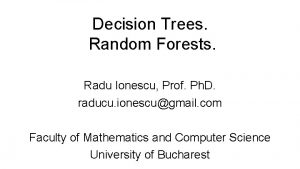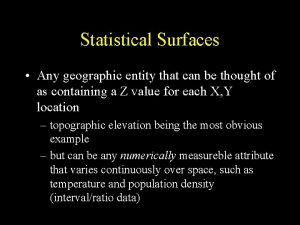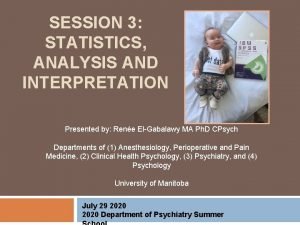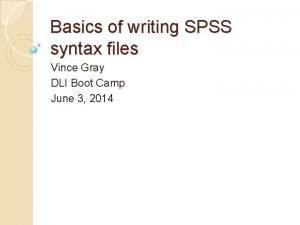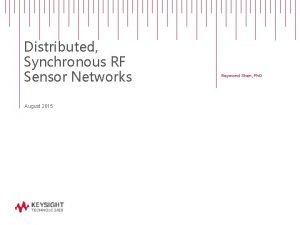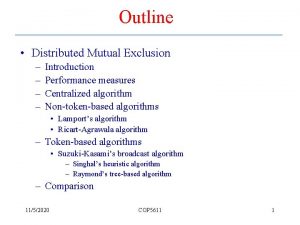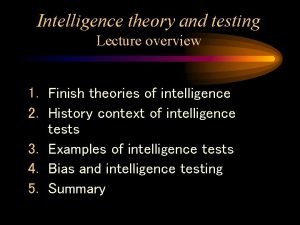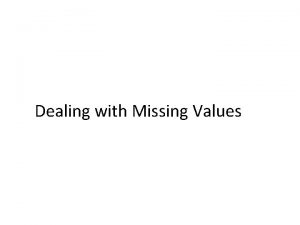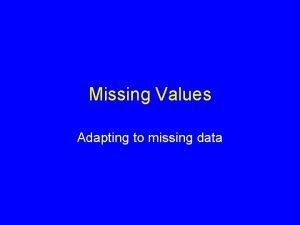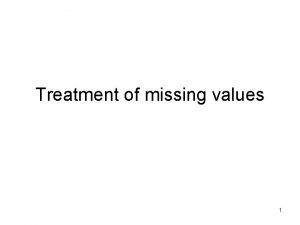Missing Values Raymond Kim Pink Preechavanichwong Andrew Wendel




































- Slides: 36

Missing Values Raymond Kim Pink Preechavanichwong Andrew Wendel October 27, 2015

I. III. IV. Intro Missing Values and Bias Simulations and Imputation Deletion Methodology Not Missing at Random

Initial Steps Why is our data missing? What is the characteristic of our missing data? https: //www. utexas. edu/cola/prc/_files/cs/Missing-Data. pdf How will that affect the bias? Mean? Std?

OLS Unbiased Estimator

Initial Steps 1. Identify the reason for missing data § Marriage, graduation, death, etc. 2. Understand the distribution of missing data § Certain groups more likely to have missing values 3. Decide on the best method of analysis § § § Deletion methods – Listwise, pairwise deletion Single Imputation Methods – Mean substitution, dummy variable, single regression Model based methods – Maximum likelihood and multiple imputation 4. Power and Bias § § Too many missing variables reduces power Introduction of bias in your estimator https: //www. utexas. edu/cola/prc/_files/cs/Missing-Data. pdf

Missing Values and Bias Are missing values moving us away or closer to the true DGP?

Conditional Distribution MCAR (missing completely at random) Probability ( Y = Missing | X, Y) = Probability (Y=Missing) Probability that Y is missing does not depend on X or Y MAR (missing at random) Probability ( Y = Missing | X, Y) = Probability (Y=Missing | X) Probability that Y is missing depends on X but not Y NMAR (not missing at random) Probability ( Y = Missing | X, Y) = Probability (Y=Missing | X, Y) Probability that Y is missing depends on Y and possibly on X Statistical Models- A. C. Davison- Cambridge University Press

Normal Data MCAR NMAR Statistical Models- A. C. Davison- Cambridge University Press

Bias Matrix – Does Bias Exist? Deletion Mean Imputation None (but reduced power) None < 0 Conditional None Unconditional Yes Conditional Yes < 0 Unconditional Yes Yes Yes Statistical Models- A. C. Davison- Cambridge University Press

Working with Missing Data MCAR MAR NMAR • Deletion • Maximum Likelihood • Multiple Imputation • Single Imputation • Sensitivity Analysis • Pattern Mixture Models • Selection Model • Maximum Entropy https: //www. utexas. edu/cola/prc/_files/cs/Missing-Data. pdf

Listwise and Pairwise Deletion NMAR BIASED Missing values are MCAR MAR Conditonal UNBIASED

Single Imputation Mean Mode Substition Dummy Variable Control Conditional Mean Substitution • Replace missing data with mean or mode • Introduces bias in estimated variance • Create indicator (1=missing, 0=not missing) • Impute missing values to a constant • Replace missing values with predicted score from a regression • Overestimates model fit https: //www. utexas. edu/cola/prc/_files/cs/Missing-Data. pdf

PRESENTATION TITLE HERE Simulations and Imputation

Imputing Values • Deal with missing data by generating values for those that are missing. • Use a variety of methods to impute these values varying in accuracy and complexity. • We will focus on single imputation methods and a few multiple imputation methods.

Mean Imputation • We can use the mean in place of the missing values • This will retain the mean from the dataset • This will also cause a negative bias in the variance

Regression Mean Imputation • Instead of using the mean, we can use regression to give us predicted values for those missing. • This may allow us to achieve better estimates http: //missingdata. lshtm. ac. uk/

Multiple Imputations • A more complex way to impute missing values. • Imputes and analyzes data to replace missing values within the data set. http: //www. stefvanbuuren. nl/mi/MI. html

A Few R Methods How can we do this in R? § Amelia § mi § There are many others, and some can be used to treat specific conditions for certain data sets.

Amelia is an algorithm that bootstraps data and uses that data in a multiple imputation process. http: //gking. harvard. edu/files/gking/files/amelia_jss. pdf? m=1360040717

mi “mi” imputes missing values using Bayesian regression methods, which are run a number of times and analyzed for convergence. This method is very customizable, but is also very costly https: //cran. r-project. org/web/packages/mi/mi. pdf

Additional Resources Additional packages that can be used in R can be found here: http: //www. stefvanbuuren. nl/mi/Software. html

Imputation Summary § In order to use imputation based methods we need to first understand the data and the reason for the “missingness” of the data. § By knowing this we can fit the method that we feel is most appropriate to our data set. § Single imputation methods can give us quick and easy answers to our missing values, but they also bias statistics like the variance. § Multiple imputation methods can handle the bias better but are complex and require more specialized R packages or software

PRESENTATION TITLE HERE Deletion Methodology

Bias • 0 means no bias • there is a systematic tendency for the estimate to be larger than the parameter it is estimating. • there is a systematic tendency for the estimate to be smaller than the parameter it is estimating. Credit: email from Dr. Westfall

Listwise Vs Pairwise Deletion What are they? • They are methods that discard data. How do they work? • Listwise (Complete-case analysis): Excluding all units for which the outcome or any of the inputs are missing. • Pairwise (Available-case analysis): Excluding a pair which contains one ore two missing values from data set. What is the difference? • Pairwise attempts to minimize the loss that occurs in listwise deletion. Credit: http: //www. stat. columbia. edu/~gelman/arm/missing. pdf]

Listwise Vs Pairwise Deletion (Cont’) Listwise deletion Pairwise deletion

Listwise Vs Pairwise Deletion (Cont’) Pros and Cons of Listwise and Pairwise deletions: • Listwise : • • The sample after deletion may not be representative of the full sample. Reducing power and type II error rates increase. Tendency to get bias results. Pairwise: • • • Preserved or increase statistical power in the analyses. The result will be the same if the data has two variables (columns) Bias (over or underestimated) Credit: https: //www. statisticssolutions. com/missing-data-listwise-vs-pairwise/ Credit: http: //files. eric. ed. gov/fulltext/ED 281854. pdf

PRESENTATION TITLE HERE Not Missing at Random

Case of NMAR § Why are our values missing? High income individuals don’t report income § What is the characteristic of the missing data Missing values are NMAR

Meboot Package https: //cran. r-project. org/web/packages/meboot/index. html

Evaluation of a Fund Manager • While evaluating a fund manager for investment you notice that the fund did not include 2008 returns for its equity fund • You highly suspect it is NMAR – It was left out because returns were bad

Evaluation of a Fund Manager • You find out that the equity fund normally held stocks representative of the entire stock market • Distribution of the missing data may follow the overall US equity market

Meboot Maximum Entropy https: //cran. r-project. org/web/packages/meboot/index. html

Meboot Maximum Entropy • • NMAR missing values requires the most assumptions Minimizing bias for NMAR depends heavily on your model setup There is no “right” answer, we do not know the true DGP All we can do is minimize bias with well grounded assumptions

Questions? THANK YOU! Questions?

 Wiaf st. wendel
Wiaf st. wendel Stephanie wendel
Stephanie wendel Mike wendels
Mike wendels Raymond kim uhn
Raymond kim uhn Andrew kim mun
Andrew kim mun Handling missing values in python
Handling missing values in python Statistical surface
Statistical surface Missing angle quadrilateral
Missing angle quadrilateral Little's mcar test
Little's mcar test Discrete missing values spss
Discrete missing values spss Instrumental values
Instrumental values Two possible values of bit
Two possible values of bit Western vs eastern values
Western vs eastern values Human values types
Human values types Instumental values
Instumental values Identify mr dolphus raymond
Identify mr dolphus raymond Raymond stewart middle school
Raymond stewart middle school David hesmondhalgh theory
David hesmondhalgh theory Raymond shen
Raymond shen Difference between metaphor and analogy
Difference between metaphor and analogy Ent raymond naves
Ent raymond naves Raymond chandler cathedral
Raymond chandler cathedral Mintzberg outlined three categories of managerial roles:
Mintzberg outlined three categories of managerial roles: Professor raymond flood
Professor raymond flood Suzuki kasami broadcast algorithm
Suzuki kasami broadcast algorithm Raymond najjar
Raymond najjar Raymond moffatt
Raymond moffatt Thurston intelligence theory
Thurston intelligence theory Raymond jiang
Raymond jiang Raymond williams analysis of culture
Raymond williams analysis of culture Yann mikaeloff
Yann mikaeloff Teleast internet prices
Teleast internet prices St raymond elementary school uniform
St raymond elementary school uniform Dato raymond liew
Dato raymond liew Mr raymond civics eoc review
Mr raymond civics eoc review Joseph pasteur
Joseph pasteur Raymond james stuart
Raymond james stuart





